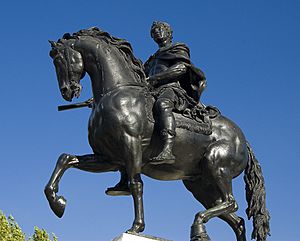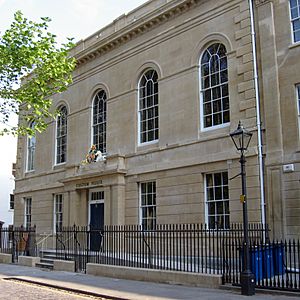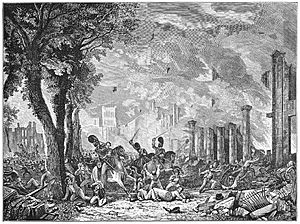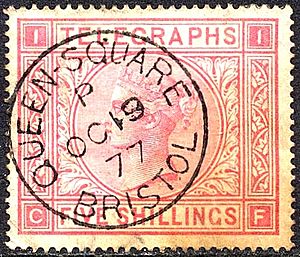Queen Square, Bristol facts for kids
Quick facts for kids Queen Square, Bristol |
|
|---|---|
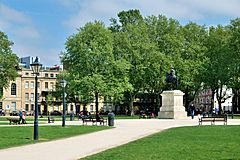
The centre of Queen Square, seen from the south-west corner
|
|
| Lua error in Module:Location_map at line 420: attempt to index field 'wikibase' (a nil value). | |
| Location | Bristol |
| OS grid | ST591722 |
| Area | 2.4 hectares (5.9 acres) |
| Created | 1699 |
| Operated by | Bristol City Council |
Queen Square is a large, open space in the heart of Bristol, England. It's about 2.4 hectares (6 acres) in size. This beautiful square was first created in 1699.
For a while, Queen Square faced some tough times. After a big event in 1831, it became less popular. Later, a busy road was built right through it in the 1930s. By 1991, lots of cars and buses were crossing the square every day. Many buildings around it were empty.
But things changed in 1999! Money from the National Lottery helped restore Queen Square. The busy road was removed, and buses were sent on a different route. The square was brought back to how it looked around 1817. Now, it's a wonderful public space again, surrounded by nice buildings.
Contents
The King's Statue
Right in the middle of Queen Square, you'll find a statue of King William III. This impressive statue was made by an artist named John Michael Rysbrack. It was cast in 1733 and put up in 1736.
The statue shows King William III on horseback. It was placed there to show the city's loyalty to the king. The statue is made of brass and stands on a stone base. It's considered a very important historical artwork.
Buildings Around the Square
Queen Square is surrounded by many interesting buildings. They show different styles from different times.
North Side Buildings
On the north side, you can see the Custom House. This building was built between 1835 and 1837 by Sydney Smirke. It's now used as offices. There's also a row of buildings from 1833 designed by Henry Rumley.
East Side Buildings
The east side has some newer buildings from the 20th century. You'll also find the Port Authority Office, built in 1889. The Sailors Refuge, which includes numbers 27–29, is a very old building from 1709–1711.
South and West Sides
The south side has many buildings from the 1700s. They look similar to other old buildings nearby on Queen Charlotte Street and King Street. The west side was rebuilt in the 1830s after a riot. Many of these buildings were designed by Henry Rumley. Some are still homes, but many are now offices.
The Bristol Riots of 1831
A very important event in Queen Square's history was the Bristol Riots in 1831. These riots happened because people were upset about voting rights.
Why the Riots Happened
At that time, only a few people in Bristol could vote. Out of 104,000 people, only about 6,000 had the right to vote. The government was trying to pass a new law called the Reform Bill. This bill aimed to give more people the right to vote and give growing cities like Bristol a stronger voice in the government.
However, the House of Lords, a part of the government, rejected this bill. This made many people very angry.
What Happened in Queen Square
On October 29, 1831, a judge named Sir Charles Wetherell visited Bristol. He was against the Reform Bill. An angry crowd chased him to the Mansion House in Queen Square. The judge managed to escape, but the mayor and other officials were trapped inside.
The protests continued for three days. Many buildings were damaged or destroyed, including the mayor's home and the city's prison. Even work on the famous Clifton Suspension Bridge had to stop!
Soldiers were called in to stop the riots. The event was very serious, and many people were hurt.
After the Riots
After the riots, about 100 people were put on trial in January 1832. Some people faced very serious consequences. This event showed how strongly people felt about having a fair say in their government.
Queen Square's Comeback
In 1937, a busy dual carriageway (a road with two lanes going in opposite directions) was built right through Queen Square. This road was part of a plan to connect different parts of Bristol. It meant some buildings were knocked down, and the King William III statue had to be moved.
By the 1980s, people realized that this busy road was spoiling the beauty of Queen Square. Plans were made to fix it.
The Road Closes
In 1992, the road through Queen Square was closed for a test period. It was so successful that it never reopened! Buses continued to go around the square for a while, but eventually, they were also rerouted.
A Beautiful Restoration
Now, Queen Square has been beautifully restored. The fences and front areas of the buildings have been put back. The large open space in the middle, with its walking paths and the King's statue, looks grand again.
The restoration of Queen Square is seen as a huge success. It's now a popular place for public events, especially in the summer. Even though sometimes parts of it can get a bit wet after heavy rain, it remains a beloved spot in Bristol.
Images for kids


